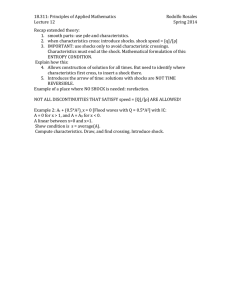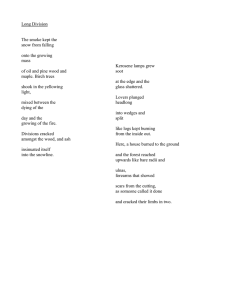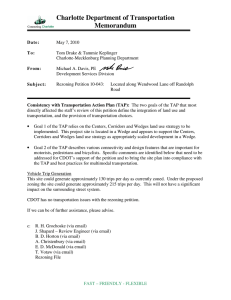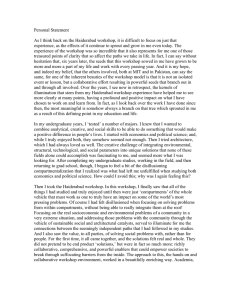APPENDICES: An application of business cycle accounting with misspecified wedges
advertisement
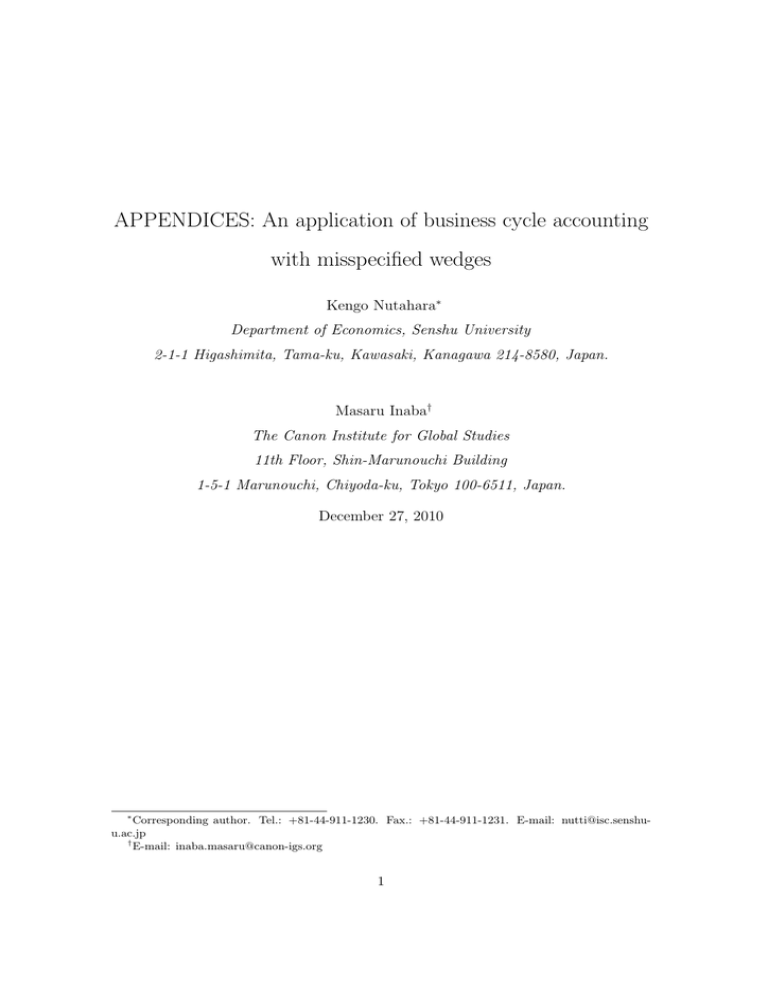
APPENDICES: An application of business cycle accounting
with misspecified wedges
Kengo Nutahara∗
Department of Economics, Senshu University
2-1-1 Higashimita, Tama-ku, Kawasaki, Kanagawa 214-8580, Japan.
Masaru Inaba†
The Canon Institute for Global Studies
11th Floor, Shin-Marunouchi Building
1-5-1 Marunouchi, Chiyoda-ku, Tokyo 100-6511, Japan.
December 27, 2010
∗
Corresponding author. Tel.: +81-44-911-1230. Fax.: +81-44-911-1231. E-mail: nutti@isc.senshuu.ac.jp
†
E-mail: inaba.masaru@canon-igs.org
1
Contents
A Model
3
A.1 Prototype economy . . . . . . . . . . . . . . . . . . . . . . . . . . . . . . .
3
A.2 Detailed economy: Medium-scale DSGE economy . . . . . . . . . . . . . .
4
B Equivalence results
8
C Procedure of BCA
10
C.1 Parameter values of the detailed economy . . . . . . . . . . . . . . . . . .
10
C.2 Definition of the true wedges . . . . . . . . . . . . . . . . . . . . . . . . .
10
C.3 Wedge decomposition . . . . . . . . . . . . . . . . . . . . . . . . . . . . .
11
D Robustness: Alternative definition of the true wedges
2
11
A
Model
In this section, we provide descriptions of our prototype model for BCA and the two
detailed economies for our experiment.
A.1
Prototype economy
The prototype economy for BCA is almost the same as that employed by CKM.1 The
log-linearized system is as follows.
The intratemporal optimization condition2 is
ct +
ℓ
ℓt = yt − ℓt − τℓ,t ,
1−ℓ
(1)
where ct denotes consumption; ℓt , labor supply; yt , output; and 1 − τℓ,t , the investment
wedge.
The Euler equation is
(1 + τx )(τx,t − ct )
{ y
[
}
y]
= β α (Et yt+1 − kt ) + (1 + τx )(1 − δ)Et τx+1 − (1 + τx )(1 − δ) + α Et ct+1 ,
k
k
(2)
where kt denotes the capital stock at the end of period t; β, the discount factor of a
household; δ, the depreciation rate of capital; α, the share of capital in production; and
1
1+τx,t ,
the investment wedge.
The aggregate production function is
yt = αkt−1 + (1 − α)ℓt + at ,
(3)
where at denotes the efficiency wedge and α denotes the cost share of capital stock in
production.
1
2
The only difference is that we consider a stationary economy.
We employ the period utility function U = log(Ct ) + γ log(1 − Lt ) following CKM.
3
The evolution of capital stock is
kt = (1 − δ)kt−1 + δit ,
(4)
where δ denotes the depreciation rate of capital.
The resource constraint is
c
i
ct + it + gt = yt ,
y
y
(5)
where gt denotes the government wedge.
In many applications of BCA, the wedges are assumed to be exogenous and evolve
according to the VAR(1) process:
st+1 = P st + εt+1 ,
(6)
where P denotes a constant matrix; st ≡ [at , τℓ,t , τx,t , gt ]′ , a vector of wedges; and εt+1 ,
a vector of i.i.d. shocks to wedges with mean zero.
A.2
Detailed economy: Medium-scale DSGE economy
Baseline economy:
We employ a medium-scale DSGE model as a laboratory for the
assessment of BCA. Here, we provide a brief description of our detailed economy.
Our economy is based on that employed by Smets and Wouters (2007). The only
difference between our detailed model and the model of Smets and Wouters (2007) is that
there are no investment-specific technology shocks in our economy. This is to guarantee
that capital stocks in the two economies are the same.3
Following Smets and Wouters (2007), we introduce the linearized version of their
model here.
3
We also apply BCA to our economy with investment-specific technology shocks in the paper.
4
The resource constraint is
yt =
i
rk k
c
ct + it +
ut + εgt ,
y
y
y
(7)
where εgt is the government expenditure shock.
The consumption Euler equation is
ct =
λ
1
ct−1 +
Et ct+1
1+λ
1+λ (
)
h
(σc − 1) wc ℓ
1−λ
+
(ℓt − Et ℓt+1 ) −
(rt − Et πt+1 + εbt ),
σc (1 + λ)
σc (1 + λ)
(8)
where εbt denotes the risk premium shock; λ, the parameter on the external habit; and
σc , the inverse of the intertemporal elasticity of substitution.
The investment Euler equation is
it =
1
β
1
it−1 +
Et it+1 +
qt ,
1+β
1+β
(1 + β)φ
(9)
where β denotes the discount factor of a household and φ denotes the steady-state
elasticity of the capital adjustment cost function.
The capital Euler equation is
[
]
k
qt = β(1 − δ)Et qt+1 + 1 − β(1 − δ) Et rt+1
− (rt − Et πt+1 + εbt ),
(10)
where qt denotes Tobin’s q and δ denotes the depreciation rate of capital.
The aggregate production function is
[
yt =
ϕp αkts
]
+ (1 − α)ℓt +
εat
,
(11)
where kts denotes capital service; εat , total factor productivity; α, the share of capital
in production; and ϕp , one plus the share of fixed costs in production, reflecting the
presence of fixed costs in production, ϕp = 1 + Φ/y.
5
The capital service, kts , is
kts = kt−1 + ut ,
(12)
where kt−1 denotes the capital stock at the end of period t − 1.
The utilization rate, ut , is determined by
ut =
1−ψ k
r ,
ψ t
(13)
where ψ denotes a positive function of the elasticity of the capital utilization adjustment
cost function and is normalized to be between zero and one.
The evolution of capital stock, kt , is
kt = (1 − δ)kt−1 + δit .
(14)
The definition of the price markup, µpt , is
[
µpt
=α
]
kts
− ℓt + εat − wt .
(15)
The New-Keynesian Phillips curve with partial indexation is
πt =
ιp
(1 − βξp )(1 − ξp )
β
πt−1 +
Et πt+1 −
µp + εpt ,
1 + βιp
1 + βιp
(1 + βιp )ξp [(ϕp − 1)εp + 1] t
(16)
where ιp denotes the degree of indexation to past inflation; ξp , the degree of price stickiness; εp , the curvature of the Kimball goods market aggregator; and εpt , the price markup
shock.
The rental rate of capital is
rtk = −(kts − ℓt ) + wt .
6
(17)
The definition of the wage markup, µw
t , is
[
µw
t
]
1
(ct − λct−1 ) ,
= wt − σℓ ℓt +
1−λ
(18)
where σℓ denotes the elasticity of labor supply with respect to the real wage.
The wage curve with partial indexation is
wt =
1
β
1 + βιw
wt−1 +
(Et wt+1 + Et πt+1 ) −
πt
1+β
1+β
1+β
ιw
(1 − βξw )(1 − ξw )
+
πt−1 −
µw + εw
t ,
1+β
(1 + β)ξw [(ϕw − 1)εw + 1] t
(19)
where ιw denotes the degree of wage indexation; ξw , the degree of wage stickiness; εw ,
the curvature of the Kimball labor market aggregator; and εw
t , the wage markup shock.
The monetary policy reaction function is
∗
rt = ρrt−1 + (1 − ρ)[rπ πt + ry (yt − yt∗ )] + r∆y [(yt − yt∗ ) − (yt−1 − yt−1
)] + εrt ,
(20)
where yt∗ denotes the natural output defined in the flexible price-wage economy.
There are six exogenous shocks in this economy. These six driving forces are assumed
to follow the following processes:
εgt = ρg εgt−1 + ηtg + ρga ηta ,
(21)
εbt = ρb εbt−1 + ηtb ,
(22)
εat = ρa εat−1 + ηta ,
(23)
p
εpt = ρp εpt−1 + ηtp − µp ηt−1
,
(24)
w
w
w
εw
t = ρw εt−1 + ηt − µw ηt−1 ,
(25)
εrt = ρr εrt−1 + ηtr ,
(26)
where ηtg , ηtb , ηta , ηtp , ηtw , and ηtr are i.i.d. shocks with mean zero.
7
Adding investment-specific technology shocks:
With investment-specific technol-
ogy shocks, our medium-scale DSGE economy changes as follows. The investment Euler
equation (9) becomes
it =
β
1
1
it−1 +
Et it+1 +
qt + εit ,
1+β
1+β
(1 + β)φ
(27)
where εit denotes the investment-specific technology shock. The evolution of the capital
stock (14) becomes
[(
) ]
kt = (1 − δ)kt−1 + δit + δ 1 + β φ εit .
(28)
The investment-specific technology shock evolves according to the following process:
εit = ρi εit−1 + ηti ,
(29)
where ηti is an i.i.d. shock with mean zero. Note that the capital stock in the detailed
economy is no longer the same as that in the prototype economy since the evolution of
capital stock (28) is different from (14).
B
Equivalence results
Here, we provide a brief description of the equivalence results in BCA.
The definition of the equivalence is as follows.
Definition 1. A detailed model is equivalent to (covered by) a prototype model if the
prototype model can achieve all realized sequences of consumption, investment, labor,
output, and capital stock generated in the detailed model.
CKM give the so-called equivalence results, the prototype model covers a large class
of frictional detailed models. However, they do not specify the types of stochastic process
of the wedges that are necessary for the equivalence; note that the VAR(1) specification
is often employed when BCA is applied to the actual data.
8
The vector of wedges, st , associated with the detailed model should be described as
st = Φxt ,
(30)
where Φ is a constant matrix and xt is a vector of endogenous and exogenous state
variables in the detailed model. The state vector xt evolves according to
xt+1 = Ψxt + ν t+1 ,
(31)
where Φ is a constant matrix and ν t+1 is a vector of structural i.i.d. shocks with mean
zero.
Using the above structure, Bäurle and Burren (2007) and Nutahara and Inaba (2008)
investigate the necessary and sufficient condition for the equivalence in the case where
the wedges of the prototype model evolve according to the conventional VAR(1) process.
They find that in many DSGE economies, the equivalence results do not hold in this
case.4 The intuition of Nutahara and Inaba (2008) yields that the equivalence results do
not hold if the number of independent endogenous and exogenous state variables in the
detailed model is greater than the number of wedges in the prototype model.
The equivalence result does not hold between our medium-scale DSGE model and
the prototype model. The number of independent state variables in our model is 12: six
endogenous states (consumption ct−1 , capital kt−1 , investment it−1 , wage wt−1 , inflation
πt−1 , nominal interest rate rt ) and six exogenous shocks (technology shocks εat , risk
premium shock εbt , government purchase shock εgt , price-markup shock εpt , wage-markup
i 5
shock εw
t , and investment-specific technology shock εt ).
4
See Theorem 1 of Nutahara and Inaba (2008) for the necessary and sufficient condition for the
equivalence.
5
We eliminate the monetary policy shock, εrt , since the current nominal interest rate, rt , contains the
information on it.
9
C
Procedure of BCA
C.1
Parameter values of the detailed economy
The parameter values of the detailed economy are given in Table 1. Most parameters are
the same as those estimated by Smets and Wouters (2007). Smets and Wouters (2007)
estimate these parameters based on the Bayesian method using the data of the postwar
U.S. economy. The differences between Smets and Wouters (2007) and the present paper
are that (i) we eliminate the trend and (ii) we set the steady-state level of labor as 31 .
[Insert Table 1]
C.2
Definition of the true wedges
In the case of the detailed economy without investment-specific technology shocks, the
true wedges are calculated using a system that consist of (i) the equilibrium conditions
of the detailed economy (7)–(26) and (ii) the equilibrium conditions of the prototype
model (1), (2), (3), and (5).
In the case of the detailed economy with investment-specific technology shocks, the
evolution of the capital stock in the prototype model (14) is different from that in the
detailed economy (28). As such, in addition to the misspecification of the stochastic
process of wedges, there is a misspecification of the evolution of capital stock in BCA.
In order to focus on the misspecification of the stochastic process of wedges, we define
the true wedges using the capital stock generated in the prototype economy.
Letting k̂t be the capital stock generated in the prototype model, the true wedges
are calculated by the system that consist of (i) the equilibrium conditions of the detailed
economy (7)–(8) and (11)–(29) and (ii) the equilibrium conditions of the prototype model
10
(1), (5), and the conditions given below:
(1 + τx )(τx,t − ct )
)
[
}
{ y(
y]
Et yt+1 − k̂t + (1 + τx )(1 − δ)Et τx+1 − (1 + τx )(1 − δ) + α Et ct+1 ,
=β α
k
k
yt = αk̂t−1 + (1 − α)ℓt + at ,
k̂t = (1 − δ)k̂t−1 + δit .
C.3
Wedge decomposition
Our method of wedge decomposition is the same as that employed by Chari, Kehoe, and
McGrattan (2007a). In wedge decompositions, the counterfactual sequences of wedges
are constructed as follows. For example, to investigate the contribution of the efficiency
wedge, it is assumed to be the same as the measured efficiency wedge with the other
wedges being constant over time. The aggregate decision rules are computed under
the specification that all wedges except the efficiency wedge are fixed constants and
the only uncertainty agents face is over the realization of the efficiency wedge. This is
the “theoretically-consistent methodology” that Chari, Kehoe, and McGrattan (2007b)
mention.
In the case of “true,” we replace the VAR(1) specification of wedges (6) with the
true stochastic process of wedges (30) and (31). This true stochastic process of wedges
(30) and (31) can be written as the VARMA(p,q) process, and this should be consistent
with the results where we employ the prototype model with the VARMA specification
of wedges.
D
Robustness: Alternative definition of the true wedges
In this paper, we define the true wedges using the capital stock of the prototype economy
in the case with investment-specific technology shocks. This is to focus only on the
problem of misspecification of the stochastic process of wedges.
Here, we show what happens if we define the true wedges using the capital stock
11
generated in the detailed economy.
Figure 1 shows the true and measured wedges in our medium-scale DSGE economy
with investment-specific technology shocks.
[Insert Figure 1]
With investment-specific technology shocks, the difference between the measured and
true investment wedges becomes larger than that in the case without investment-specific
technology shocks while the other wedges are measured almost correctly. In the case,
there should be a mismeasurement of the efficiency wedge since the two capital stocks
are different in the prototype economy and the detailed economy. However, Figure 1
shows that this difference is quantitatively quite small.
Table 2 reports the cyclical behavior of the true and measured investment wedges.
[Insert Table 2]
The correlation between the true and measured investment wedges becomes smaller, and
the RMSE indicates that the difference between the two investment wedges is about 1.6
percent. However, the measured investment wedge seems to be close to the true one. At
least, the measured investment wedge captures the abstract of the dynamics of the true
one.
In this case, there are two sources of mismeasurement of the investment wedge: (i)
the difference in capital stocks and (ii) the increase in the number of the state variables.
We find that the impact from reason (i) is small.
Figure 2 shows the output decomposition by each wedge
[Insert Figure 2]
For efficiency, labor, and investment wedges, the differences between the output predictions of the true and measured wedges are still small.
Table 3 reports the cyclical behavior of the output predictions by the true and measured investment wedges.
[Insert Table 3]
12
The RMSE is about 1.5 percent. Finally, we conclude that BCA is empirically useful
even in this case.
References
[1] Bäurle, G., Burren, D., 2007. A note on business cycle accounting, University of Bern,
Discussion Paper 07–05.
[2] Chari, V.V., Kehoe, P.J., McGrattan, E.R., 2007a. Business cycle accounting, Econometrica 75, 781–836.
[3] Chari, V.V., Kehoe, P.J., McGrattan, E.R., 2007b. Comparing alternative representations and alternative methodologies in business cycle accounting, Federal Reserve
Bank of Minneapolis Staff Report 384.
[4] Nutahara, K., Inaba, M., 2008. On equivalence results in business cycle accounting,
RIETI Working Paper 09–E–18.
[5] Smets, F., Wouters, R., 2007. Shocks and frictions in U.S. business cycles: A Bayesian
DSGE approach. American Economic Review 97, 586–606.
13
Figure 1: True and measured wedges (3): With investment-specific technology shock
(Alternative definition of the true wedges)
Efficiency Wedge
5.2
Labor Wedge
True
BCA
True
BCA
0.75
5
0.7
4.8
0.65
4.6
0.6
4.4
0
50
100
150
200
0
Investment Wedge
50
100
150
200
Government Wedge
1
True
BCA
1.1
True
BCA
0.9
0.8
1.05
0.7
1
0.6
0.5
0.95
0.4
0.9
0
50
100
150
200
0
50
100
150
200
Notes: The blue solid lines are the true wedges that are consistent with the
Smets-Wouters economy. The red crosses are the measured wedges by BCA.
The wedges in the figures are levels (and not log-deviations).
14
Figure 2: Output decomposition by the true and measured wedge (3): With investmentspecific technology shock (Alternative definition of the true wedges)
Efficiency Wedge Only Economy
Labor Wedge Only Economy
3.6
3.6
3.4
3.4
3.2
3.2
3
3
2.8
Data
0
50
BCA
100
2.8
True
150
200
Data
0
Investment Wedge Only Economy
3.6
3.4
3.4
3.2
3.2
3
3
Data
0
50
BCA
100
2.8
True
150
100
True
150
200
Government Wedge Only Economy
3.6
2.8
50
BCA
200
Data
0
50
BCA
100
True
150
200
Notes: The blue dashed-dotted lines are the actual output data. The red bold
solid lines are the output predictions by the measured wedges. The green solid
lines are the output predictions by the true wedges.
15
Table 1: Parameter values of the detailed economy
symbol
σc
σℓ
λ
ξw
ξp
ιw
ιp
φ
ψ
Φ
ρ
rπ
ry
r∆y
π̄
−1
100(β − 1)
ℓ̄
α
δ
λw
εp
εw
g/y
σa
σb
σg
σi
σr
σp
σw
ρa
ρb
ρg
ρi
ρr
ρp
ρw
µp
µp
ρga
description
relative risk aversion
elasticity of labor supply with respect to the real wage
habit persistence
wage stickiness
price stickiness
wage indexation
inflation indexation
steady-state elasticity of the capital adjustment cost
elasticity of the utilization adjustment cost
fixed cost in production
Taylor rule (past interest rate)
Taylor rule (inflation)
Taylor rule (output (1))
Taylor rule (output (2))
steady-state quarterly inflation
discount factor
steady-state labor supply
share of capital
depreciation rate of capital
steady-state markup in labor market
Kimball aggregators in goods market
Kimball aggregators in labor market
steady-state ratio of government spending to output
std of technology shock
std of risk-premium shock
std of government shock
std of investment-specific technology shock
std of monetary shock
std of price markup shock
std of wage markup shock
persistence of technology shock
persistence of risk-premium shock
persistence of government shock
persistence of investment-specific technology shock
persistence of monetary shock
persistence of price markup shock
persistence of wage markup shock
MA parameter of price markup
MA parameter of wage markup
relationship between technology and government shocks
16
values
1.39
1.92
0.71
0.73
0.66
0.59
0.22
5.48
0.54
1.61
0.81
2.03
0.08
0.22
0.81
0.16
1/3
0.19
0.025
1.5
10
10
0.18
0.45
0.24
0.52
0.45
0.24
0.14
0.24
0.95
0.18
0.97
0.71
0.12
0.90
0.97
0.74
0.88
0.52
Table 2: Cyclical behavior of the true and measured investment wedges (3): With
investment-specific technology shock (Alternative definition of the true wedges)
true
VAR(1)
mean
1.0018
1.0027
std
0.0314
0.0231
autocorr.
0.9671
0.9790
corr. w/ yt
-0.1192
-0.1034
corr. w/ true
–
0.8630
RMSE
–
0.0164
Notes: Means, standard deviations, autocorrelations, correlations with
the current output, correlations with the true investment wedge, and
the RMSE are reported. The RMSE is the root mean squared error of
the percentage-deviations between the true and measured investment
wedges.
Table 3: Cyclical behavior of the predicted output by the true and measured investment
wedges (3): With investment-specific technology shock (Alternative definition of the true
wedges)
true
measured
mean
3.2224
3.2166
std
0.0649
0.0398
autocorr.
0.9453
0.9687
corr. w/ true
–
0.6901
RMSE
–
0.0147
Notes: Means, standard deviations, autocorrelations, correlations with
the actual current output, correlations with the output prediction by
the true investment wedge, and the RMSE are reported. The RMSE is
the root mean squared error of the percentage-deviations between the
two output predictions by the true and measured investment wedges.
17
